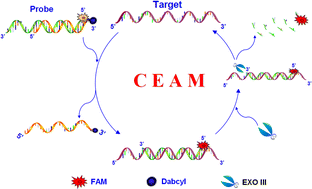A cyclic enzymatic amplification method for sensitive and selective detection ofnucleic acids
Abstract
Based on

* Corresponding authors
a
State Key Laboratory for Physical Chemistry of Solid Surfaces, The Key Laboratory for Chemical Biology of Fujian Province, The Key Laboratory of Analytical Science, and Department of Chemical Biology, College of Chemistry and Chemical Engineering, Xiamen University, Xiamen, China
E-mail:
cyyang@xmu.edu.cn
Fax: +86 592 2189959
Based on

 Please wait while we load your content...
Something went wrong. Try again?
Please wait while we load your content...
Something went wrong. Try again?
L. Cui, G. Ke, C. Wang and C. J. Yang, Analyst, 2010, 135, 2069 DOI: 10.1039/C0AN00215A
To request permission to reproduce material from this article, please go to the Copyright Clearance Center request page.
If you are an author contributing to an RSC publication, you do not need to request permission provided correct acknowledgement is given.
If you are the author of this article, you do not need to request permission to reproduce figures and diagrams provided correct acknowledgement is given. If you want to reproduce the whole article in a third-party publication (excluding your thesis/dissertation for which permission is not required) please go to the Copyright Clearance Center request page.
Read more about how to correctly acknowledge RSC content.
 Fetching data from CrossRef.
Fetching data from CrossRef.
This may take some time to load.
Loading related content
